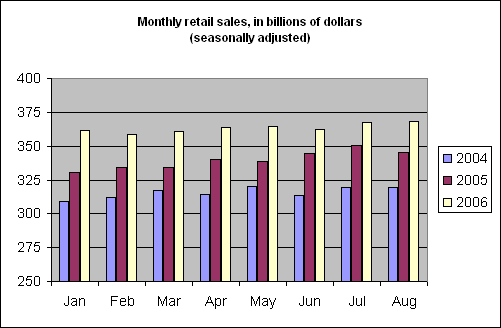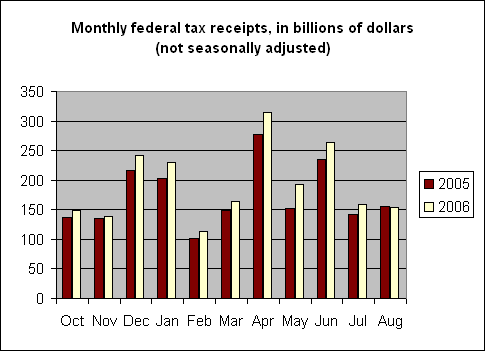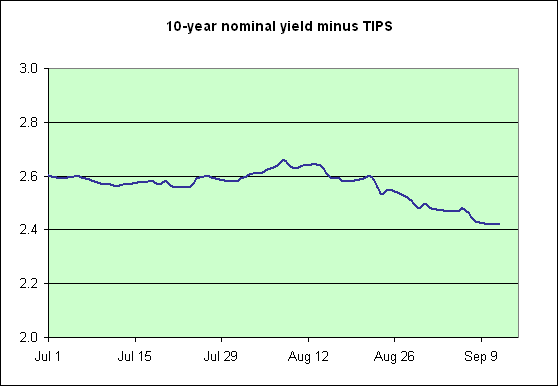Some analysts, convinced a catastrophe is looming, are starting to jump at shadows. But this week’s numbers do not give me much cause for alarm.
William Polley quite appropriately took the New York Times and Martin Crutsinger, economics writer for the Associated Press, to task for trying to twist yesterday’s report from the Census Bureau on August retail sales into something negative or worrisome. Sayeth the AP:
Retail sales posted only a modest gain in August as worried consumers got hit anew with sticker-shock at the gasoline pumps. The nation’s retailers recorded a tiny 0.2 percent increase following a much bigger 1.4 percent rise in July. It was the weakest performance since sales had actually fallen by 0.5 percent in June.
As if the rate of increase every month is supposed to be bigger than the previous. Here’s what the seasonally unadjusted figures actually show:
 |
Looks to me like the downward trend of the earlier summer was in fact reversed in August, with solid year-to-year comparisons all along. And here are the seasonally adjusted data that the quotation above endeavored to summarize:
 |
If this is the worst we’ve got, we’re in pretty good shape.
While the AP frets over these seemingly mild-mannered numbers, Macroblog spots something more worrisome in the drop in U.S. Treasury receipts for August:
 |
Here is something new, and if a drop in the aggregate level of economic activity is indeed underway, this might be the first subtle indication. But there’s so much noise in this particular series, it’s just as easy to view this as just another blip.
On the inflation front, I would think the Fed would take some comfort in the declining indicator of expected inflation implied by the nominal-TIPS spread,
 |
not to mention the ongoing dramatic slide in gasoline prices. All of which seems to have left the price of September or October fed funds futures contracts within a basis point of 5.25%, while the November contract is at 5.28%.
In other words, traders are persuaded there is very little chance of any change in the fed funds target at the September 20 FOMC meeting, and give only a token nod toward the possibility of a hike at the October 24/25 meeting.
That sounds about right to me.
Technorati Tags: macroeconomics,
Federal Reserve
“This is your Captain speaking. I have decided that we will not be coming in for a landing. Those of you who were planning to exit must remain in your seats.”
Oh well…if you can’t figure out how to land the damn thing properly then why land it at all.
Retail sales are a lagging indictor. Don’t miss the landing………….
James,
Once again a great analysis.
I especially found the graph of monthly federal receips to be interesting. What we seem to see is a decline in the month following a decline in business. But it must also be noted that as business declines there is a huge drop in federal receipts. This should not be a surprise since a company can have sales with no taxable income in a declining economy.
This is a good indication that if we want to balance the budget we must allow business to prosper rather than hindering business by raising taxes and interest rates. The FED attacks on the economy have a negative effect on business receipts and increase the federal deficit.
Is that TIPS spread drop as precipitous as it looks here? Seems like it could be a leading indicator of an economic slowdown. Maybe the market sees the Fed lowering rates again by early next year.
I agree; each little data point should not be read into so much. This is why I value the trend-centric analysis at this and other fine blogs.
But this also means I find no evidence for major structural changes in the overall balance sheet situation, which is a bad thing.
And I think major problems won’t show up in the prevailing metrics until its too late, because they rely on an “inflection point” in ability to keep up with debt. Things will get really interesting when the rate of consumer credit acquisition slows down markedly.
News of the World #2
Elsewhere… The State: An Anecdote, Don Boudreaux pretty much sums up the rationale for consequentialist libertarianism: “Minimum amount of USDA farm subsidies since 2000 that have been paid out to people who do not farm: $1,300,000,000.R…
Retail Sales
There’s discussion about how to interpret the latest retail sales figures. William Polley has the links, as does James Hamilton. The main point is to be careful about interpreting monthly data as it is very noisy. To see this graphically,
interesting your analysis but i think data sales are nominal and not measured in real terms, so the picture would be really bad
Carmelus, the seasonally unadjusted August 2006 number is 6.8% higher than the August 2005 value, well above any measure of inflation over that period.
The AP Talks Down The Economy
You gotta hand it to the MSM. They never give up. Today’s example of extreme bias is this article written by Liz Sidoti with this headline:
GOP talk of vibrant economy rings hollow
She then goes on to detail a person sobbing about 3 dollar used…
tens of thousands of auto workers being laid off; dozens of plants closing…
housing market supply now going parabolic; hundreds of realtor-brokers and mortgage bankers, thousands of construction, re-modelling workers, etc., leaving this industry…
commodity boom-bubble has burst; massive losses by some hedge funds…
AngloAmerican Occupation forces are now, quite literally “circling the wagons” = entrenching themselves in Barricade Baghdad; in Afghanistan, AngloAmerican forces are pleading with their leaders to either RESCUE or REINFORCE them…
and the YIELD CURVE is flatter than a store-bought tortilla.
meanwhile, YOU LOOK AT THE PRESENT THROUGH A REAR-VIEW MIRROR: YOU MARCH BACKWARDS INTO THE FUTURE.